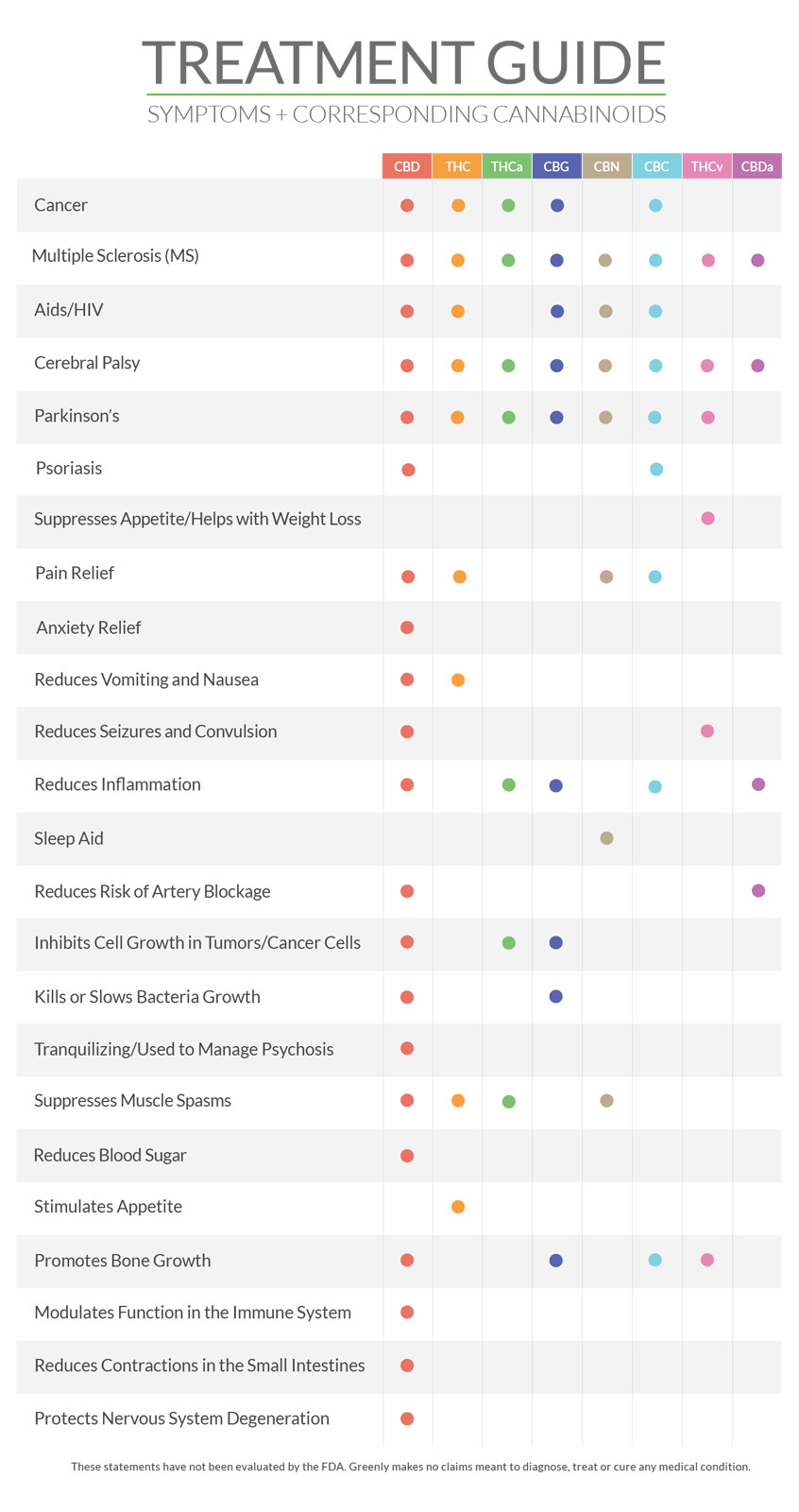Many people, who are considering cannabis as a medical treatment, have asked us to help simplify their research and help make their decisions a little easier. So, we’ve created a handy Treatment Guide that lists many of the medical conditions for which cannabis treatments are currently being prescribed. It also shows which of the main chemical compounds found in cannabis actively contribute to its effectiveness in treating these conditions.
Our Treatment Guide doesn’t tell the full story of the Power of the Plant™ or conclusively prove that medicinal cannabis is an appropriate treatment for what ails you. But it’s a good place to start learning and good way to jump-start a conversation with your doctor.
At this point, we should mention that while the Food and Drug Administration (FDA) acknowledges decades of “significant interest in the potential utility of marijuana for a variety of medical conditions,” it has not approved “botanical” cannabis or any of its individual chemical compounds as “a safe and effective treatment for any indication.”
However, a mountain of “peer-reviewed research” – credible scientific studies and controlled testing results published in the most respected science and medical journals around the world – indicates that cannabis and various extracts derived from the plant are effective in treating the symptoms of a wide range of medical conditions from ALS (Lou Gehrig’s Disease) to Tourette’s Syndrome.
This mounting evidence is one of the main reasons why many states have either approved or are in the process of approving the sale of cannabis products for medicinal purposes.
Using the Guide
Many chemical compounds in the cannabis plant have a wide range of positive effects on human health. These are known as cannabinoids. Our Treatment Guide shows which of the eight main types of cannabinoids make cannabis effective in treating a particular condition.
But it’s important to understand that it’s not the number of cannabinoids that make a treatment more or less effective.
For example, there is only one main cannabinoid that suppresses the appetite. There are only two that help alleviate nausea. However, if these cannabinoids are present in sufficient amounts in the treatment, they can be extremely effective. On the other hand, all eight main cannabinoids work together to make cannabis an effective treatment for many symptoms of MS and Cerebral Palsy.
Simply find your medical condition or symptoms in the left column of the Treatment Guide and see which cannabinoids contribute to an effective treatment.
Once you talk to your doctor and receive a prescription for medical cannabis, you can visit a Shango store and ask any customer service representative to help you select the best product(s) for your treatment.
All cannabis strains are different and have different amounts of various cannabinoids. Our team can recommend a strain with higher concentrations of the appropriate cannabinoids that will give you the most relief.
About Those Abbreviations
To save space, our Treatment Guide uses the common abbreviations of the eight main cannabinoids’ long and somewhat confusing chemical names. Here’s what they mean and a little bit more information about each of them.
CBD (Cannabidiol) is one of the three cannabinoids present in cannabis in the highest concentrations and it has many health-giving and therapeutic effects. CBD is not “psychoactive.” In other words, it doesn’t make you high. In fact, it actually reduces the intoxicating effects of cannabis.
THC (Tetrahydrocannabinol) is another cannabinoid usually found in the highest concentration in cannabis. THC is the one that makes you high, but it also has many therapeutic effects. For example, studies have show that THC may actually help protect and even regenerate brain cells.
THCa (Tetrahydrocannabinolic Acid) is the chemical “precursor” to THC. When you smoke or vape cannabis the heat turns non-psychoactive THCa into psychoactive THC. This explains why you don’t get high if you eat raw cannabis.
CBG (Cannabigerol) is like the mother of all cannabinoids. It works behind the scenes to help form almost all other cannabinoids. Its considerable medicinal effects are only just becoming understood.
CBN (Cannabinol) is non-psychoactive and has a unique profile of benefits and effects, which is the subject of intense study. The discovery of CBN forever changed the global perception of cannabis from that of a dangerous drug to a source of hope for suffering patients.
CBC (Cannabichromene) is one of the high-concentration cannabinoids. It helps relieve pain, inflammation and depression, and even fights bacterial infections. Studies also show it’s promising effect of stimulating brain growth.
THCv (Tetrahydrocannabivarin) is a variation of THC that provides different effects and benefits. It does intensify THC’s euphoria, but in a way that stimulates clarity. It suppresses appetite and anxiety, and may help regulate blood sugar levels.
CBDa (Cannabidiolic Acid) is the heat-activated precursor to CBD. It helps fight nausea, inflammation and infection, but studies now indicate it may have an important role in inhibiting the growth of cancer cells.
We hope you’ll find our handy Treatment Guide easy to use and helpful in determining if cannabis can provide and effective remedy for your medical condition.



